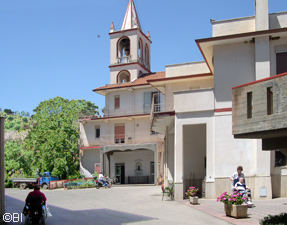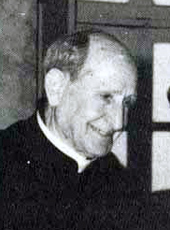| ||||||||||
Antonino Marcantonio A life dedicated to others, the poorest
He has enriched his native town of a prestigious, socially useful institute that meritoriously is called with his name: “Rest Home S. Vincenzo de’ Paoli - Father Antonino Marcantonio”. Born in Bronte from Nunzio and Antonina Catania on the 16th of January 1906, when he was fourteen, in 1920, while he was already engaged in some work (he used to tell that was working as a carter) he meets father Giuseppe Salanitri that a year before had started the Little Seminary, and decided to become a priest. In the house school of father Salanitri he had his first years of study the Little Seminary; in 1924 entered Catania’s Archiepiscopal Seminary and on the 10th of July 1934 was ordered priest by Mons. Carmelo Patanè. His first pastoral experiences were in Catania. Then from 1936 until 1943, he was the parish priest of a nearby country town S. Pietro Clarenza, where, defending the freedom of the church, he found himself at odds with the Fascism and, during the war, did his outmost to help the needy. In 1943 goes back to Catania, as parish priest of the Santa Maria della Salute church at Picanello and participates actively with the Dioceses for the post war reconstruction; was part of the diocesan group that through the P.O.A. (Papal Opus Assistance) made available to the needy, the help coming from America. In 1948, during the first political elections, he did as much as he could to impede the advance of communism and favor the success of the catholic party; in the same time he was part of the “Movimento Mondo Migliore” (Movement for a better world), founded by the Jesuit father Lombardo for the renewal of the church’s pastoral life.
In Bronte father Marcantonio plays a leading part in the life not only religious but also social and cultural of the country town, continuing his struggle for the success of the catholic group in the political life and for the revival of religious life in Bronte. He tried to help them any way he could, pointed out the most urgent cases to the only two welfare centers operating in Bronte (the one for men “ San Biagio’s Conference”, formed in 1926, and that for women “Dame di carità di San Vincenzo”, founded in 1940) but this didn’t amount to much. «Some medicine, few kilos of pasta and bread, some discarded garments, naturally could not resolve the problems requested by some cases.» To meet the needs and the requirements of this mass of poor and neglected people then he prefigured a courageous and challenging solution: to found a house for lonely or needy old people. He launched the idea to the two charity associations in July 1959. «The difficulty - he wrote - facing us was when there were elderly of both sexes, poor and needy…. sometime also sick and above all abandoned, induced us to formulate our particular idea, to start a challenging but necessary work, to realize some social institution that Bronte did not have but particularly needed.» To realize "his dream" he worked with tenacity and perseverance among economic difficulties, ostracism and obstacles of every kind, but he realized it only six years after: in 1965 the construction works were, in fact, completed. In 1967, with the admission of the first seven elderly, was inaugurated the first unit of the Home dedicated to “San Vincenzo de’ Paoli” and, in subsequent years, with decision and tireless dedication, he brings it to the actual impressive and functional structure.
At eighty three years of age, in 1989, he retired from his office of parish and archpriest and went to live for good in the Rest Home that he had founded. He chose to dedicate to the elderly the last years of his life. He dies during the morning of the 14th of July 1997 struck by a heart attack. The solemn funeral was celebrated in the Main Church with a great participation of Bronte’s inhabitants; the function was presided by the archbishop Bommarito and attended by all Bronte’s clergy and many priests of Catania’s Dioceses. He was buried in Bronte in the clergy’s cemetery Chapel. With the decree of the 22nd of June 1997, mons. Bommarito decided to call the Rest Home “Casa di riposo Vincenzo de' Paoli - Padre Antonino Marcantonio". On the 29th of June 2004, in the Rest Home’s garden, in the presence of institutional authorities, Catania’s metropolitan archbishop, Mons. Salvatore Cristina, shall unveil an artistic and imposing monument in his memory. | ||||||||||
| ||||||||
| ||||||||
| ||||||||
| ||||||||
| ||||||||
 He is remembered in Bronte for his tenacity, determination, and, we have to say it, also the courage to pursue his dream; the construction of a Home for old people with no relatives, for poor people, outcast and generally needy.
He is remembered in Bronte for his tenacity, determination, and, we have to say it, also the courage to pursue his dream; the construction of a Home for old people with no relatives, for poor people, outcast and generally needy. On the 18th of May 1954 comes back to Bronte. The then Catania’s Archbishop Mons. Guido Luigi Bentivoglio, nominates him parish archpriest of the
On the 18th of May 1954 comes back to Bronte. The then Catania’s Archbishop Mons. Guido Luigi Bentivoglio, nominates him parish archpriest of the  In 1984 his tireless social commitment obtains a small recognition: Giovanni Paolo II, in gratitude of his long and fecund apostolate at the Church’ service, nominates him his domestic prelate with the title of Monsignor.
In 1984 his tireless social commitment obtains a small recognition: Giovanni Paolo II, in gratitude of his long and fecund apostolate at the Church’ service, nominates him his domestic prelate with the title of Monsignor.







 The work wasn’t yet finished. “Father archpriest”, (as the people called father Marcantonio), kept on raising funds and sell burial cards.
The work wasn’t yet finished. “Father archpriest”, (as the people called father Marcantonio), kept on raising funds and sell burial cards. With the comprehension, the solidarity and the liking of all the people, that grew day by day.
With the comprehension, the solidarity and the liking of all the people, that grew day by day. In the posters and “proclamations” that father Marcantonio used to spread in order to press for the traditional generosity of Bronte’s people, he often spoke of what had been done in the past by other benefactors: I
In the posters and “proclamations” that father Marcantonio used to spread in order to press for the traditional generosity of Bronte’s people, he often spoke of what had been done in the past by other benefactors: I Today the Fund “Institute S. Vincenzo de’ Paoli – Padre Antonino Marcantonio” is a flower to Bronte’s buttonhole, a small autonomous village, with a church, infirmary, kitchen and dining hall, laundry, generator, ample tree lined spaces, court-yards and terraces, living and reception rooms, double rooms with internal toilets, storerooms with refrigerators, garage, barber’s room, mortuary and …many elderly living together, less lonely and lovingly assisted.
Today the Fund “Institute S. Vincenzo de’ Paoli – Padre Antonino Marcantonio” is a flower to Bronte’s buttonhole, a small autonomous village, with a church, infirmary, kitchen and dining hall, laundry, generator, ample tree lined spaces, court-yards and terraces, living and reception rooms, double rooms with internal toilets, storerooms with refrigerators, garage, barber’s room, mortuary and …many elderly living together, less lonely and lovingly assisted.